With the upcoming atrocious merger of Monsanto and Bayer we will continue to see challenges from neonicotinoids and a mindset that is adding to bee decline. When their former CEO’s and marketing staff are lobbyists or actually head our regulatory agencies we can expect even worse. Who can sue Monsanto, much less this new mega International conglomerate? Will our legislators fight such internationals? Heck no, most have been paid off.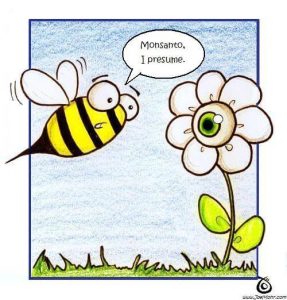 |
That still leaves a lot that people can do on a local level.
1. Plant pollinator-friendly plants, both for nectar and for pollen. **
2. Be super careful in using any pesticide and attempt to find organic alternatives – or live with the problem – often nature will step in and solve the temporary imbalance.
3. Learn to value weeds – Dandelions, clovers, Veronica, fireweed, thistle loosestrife, milkweed, goldenrod and other flowering weeds are crucial food sources for bees. In urban areas filled with sprawling lawns, dandelions and clovers are often lifesaving oases for bees. Deadhead when they have finished their bloom and before they go to seed – sometimes not – seed heads of asters are what hummingbirds make nests out of. Other plants such as nettle are great bee plants.
4. Plague your legislators to support policies like the Pollinator Recovery Act and fight this administration if it becomes one more Obama legacy Trump tries to kill.
5. Get your community involved and work to change the restrictive law regarding bees and even raising a few chickens. I say this because my small community of Sequim WA does not even allow a few Rooster less chickens to be raised. “We’ve removed ourselves so far from our food sources that the re-introduction of these practices seems odd and even worrisome to people who haven’t been exposed.” And it is those very same people who make the restrictive laws in what used to be a vibrant farming community.
6. Join a local bee club and support their efforts. Our own North Olympic Peninsula bee club has a great newsletter and informative Monthly meetings.
Most of all: Plant the following Bee nurturing gems if you can.
If you live in a milder climate zone you could add many S. African and Australian plants such as Grevillia and Bottlebrush. Fremontia a CA native was literally dripping with nectar and on my former hillside I had planted a riot of Grevillia (RED) and Ceanothus (BLUE) – Liberace would have been proud.
Bees are more active in gardens that provide at least 10 species of their favorite plants. Similarly, they ignore gardens with only one or two favorites. Highly manicured, heavily mulched gardens repel them. Providing a variety of flowering plants that provide successive flowering through spring, summer, and fall form the foundation of the insect-friendly garden. Remember, many of the same plants will also attract butterflies and hummingbirds.
In summary: A balanced mix of native and exotic plants in a garden free from pesticides, keeps honey bees as well as native species foraging happily throughout the blooming seasons.
As this site progresses, I will further try to arrange the following plants month by month as they bloom in the Pacific Northwest.
Bulbs:
Snowdrops (Galanthus) red pollen -Scilla Siberian Squill, Crocus, some specie tulips. Later bulbs include fritillaria, alliums and English bluebells.
Flowers and Perennials:
Lavender, catmint, monarda, rosemary, sage, cilantro, thyme, fennel, rosemary, hyssop, borage, aster, hollyhocks, anemone, phlox, calendula, sweet alyssum, poppies, sunflower, zinnia, cleome, heliotrope, chives, ageratum, sunflowers, Perovskia, Eryngium, goldenrod and so many more.
Ground covers:
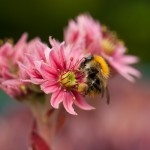
Hardy Iceplant, Erodium all sedums, sempervivum, Heuchelli, manzanita, cotoneaster, lithodora and European ivy, Hypericum
Shrubs:
Abelia, Cistus (Rockrose), Ceanothus, Pieris, Aronia, Buddleia, Blueberries, Arbutus unedo – Strawberry tree, Escallonia, Euonymus, Mahonia, Manzanita. Bees favor old garden roses such as Bourbons, moss and Rosa rugosa especially. Photinia, Flw. Current, (Ribies Sanguinea) Viburnum, Philadelphus (Mock Orange), Photinia, Common Privet (bad tasting honey),
Trees:
Eucryphia ! Catalpa Tulip tree, Chitalpa tashkentensis, Honey Locust, Black Locust, Sourwood, Amelancher( Service Berry) Redbud, Sumac, Sambucus nigra ‘Black’ one of those many lovely red leafed forms, Tamarisk, Strawberry tree, Madrona All fruit trees.
Vines :** honeysuckle, clematis, esp. (C. armandii and montana species) and of course Wisteria.
Weeds: mustard – dandelion pollen, thistle nectar and pollen, fireweed
Honeybees further pollinate the normal vegetable garden – Sentient pumpkins ( see comment), squash, cucumbers, zucchini and these flowering vines, in turn provide a valuable food source for them. Bees acquire pollen for protein, vitamins, minerals and nectar for energy from these summer garden favorites. RED pollen – now where did that come from. 🙂
Overwintering Your Hives:
Both pollen and nectar are incredibly important and in short supply. Local pollen count by the day, just enter your Zip code.
JANUARY, FEBRUARY and MARCH
Cottonwood, Eucalyptus, Willow esp. pussy willow. Pussy willow blooms are seen as the soft gray arrangements along the branch, but they are really the “bud” stage of the bloom. Here on the right, we can see the yellow and red color of the actual flower stamens.
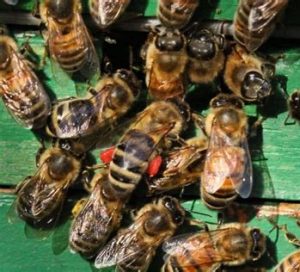 |
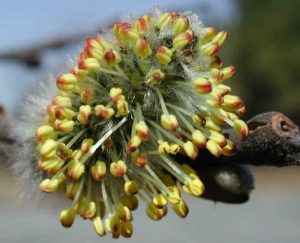 |
In the Pacific Northwest Cottonwood and Alder trees are a major supplier of pollen and in CA and elsewhere Eucalyptus fills the menu. Some bulbs and annual weeds also begin to bloom and provide pollen. Calluna, Erica (heaths) are blooming.
MARCH: is the month we all have been waiting for and in milder areas, Citrus is one of the first nectar-bearing trees. Many desert wildflowers and shrubs also begin – Mesquite being one. In the Pacific Northwest, we rely on the Ribies sangineum and Indian Plum (Oemleria.) The native Acer glabrum and circinatum provide great nectar flows and Dandelions provide both nectar and pollen.
Berberis and two varieties of Mahonia (Oregon Grape) are also in bloom.
Bulbs have also done their bit. Snowdrops (Galanthus) red pollen, Scilla Siberian Squill
APRIL: The earliest fruit trees to bloom would be the plums and if the weather is wet and unkind they sometimes will not get pollinated. Perhaps leaving the first blooming dandelions might be a good idea – pollen producer. MAPLES be they the native or hybrid forms all are great pollen and nectar sources. Hazel bushes including the contorted filbert are also heavy pollen producers. Crabapple, apples and plum are in full swing. Symporicarpos snowberry is an unnoticed native but provides nectar.
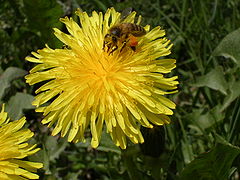
MAY: Apple and cherry trees are primary nectar trees in May and towards the end of the month bees will be attracted to the Pink Tamarisk which looks delightful with Ceanothus as does the Fremontia. Amelancher, (Serviceberry) Ribies sanguineum, Arbutus (Madrona) Flowering Quince and Laburnum are heavily visited for both pollen and nectar, so is Heather. Raspberries, Blueberries are finishing but Photinia and many other shrubs are coming into full bloom as are tons of perennials: Phlox, Lithodora, poppies and many more.
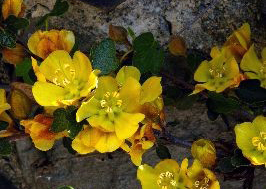 |
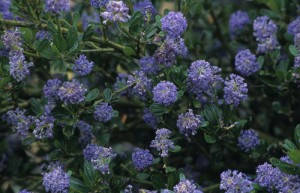 |
JUNE: Honey Locust (Gleditzia), Holly, Ash are three heavily visited trees now. Later on, Walnut trees provide pollen and the feral Horse chestnut – RED pollen. If you are fortunate to have a LARGE property the Tulip tree Liriodendron tulipifera is an awesome honey producer as are the raspberries and even better the blackberries and
Gaulnettya Wisley Pearl, Oxydendrum (Sourwood), Pernettya, Vaccinium (huckleberry). Madrona and dogwood are both good May/June nectar trees.
Oriental poppy and Opium poppy are producing tons of grey pollen in this month and into the next. Sorry – no opiate honey, it is all pollen. Same for HEMP which is wind pollinated. 🙂
JUNE JULY
Crimson and white clover – nectar and pollen. (light brown) Euonymus and many common landscape shrubs such as Photinia, Cotoneaster, Ceanothus, and Wisteria are being visited. Chitalpa, Philadelphus, Sambucus (Elderberry) is heavily visited. Agastache foeniculum (Anise hyssop), as well as Asters, will play well into fall. Phlox is blooming well and Sedum, Hen and Chicks, Valarian, Rosemary are just beginning.
JULY: Perovskia, Cosmos, Caryopteris, Coreopsis, Penstemon and many of the cultivated flowers come into play now as well as the Sequim famous lavender. Groundcover thymes are heavily visited.
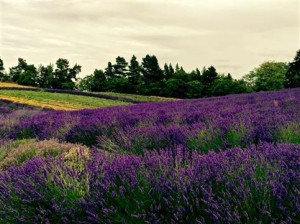 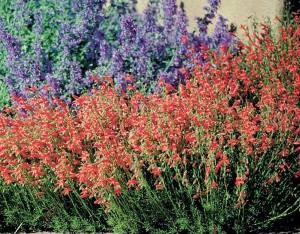 |
AUGUST: Echinacea, Penstemon, continue to bloom, Epilobium augustifolium (Fireweed) and Thistle both are nectar producers. Solidago goldenrod begins as do the mints. Melissa officinalis (Beebalm) Monarda. The Black Locust comes into flower in late JULY/AUGUST. Atlhea or Rose of Sharon is a great bee plant as is Abelia grandiflora.
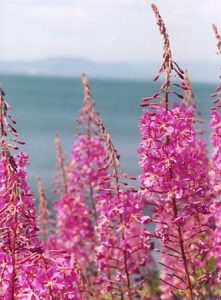 |
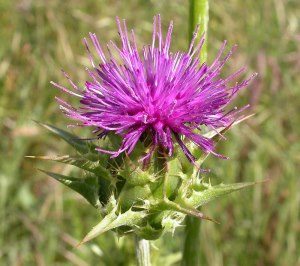 |
SEPT:
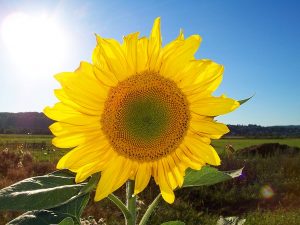 Sunflower – nectar and pollen
Sunflower – nectar and pollen
The FALL months:
European Ivy – nectar
WINTER: Arbutus unedo, Eucalyptus, in milder regions Citrus
OTHER LINKS – other stories.
My bear and bee adventures – as in sometimes things go wrong.
A web-based introduction to raising bees. Over 30 videos!
Tower Hives And Varroa control
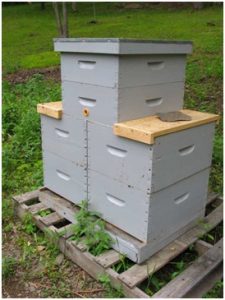
The link to Bayer above is but ONE of four videos regarding their culpability with insecticides.
“In 1992 Bayer was granted a license to use its systemic insecticide ‘Gaucho’ on Sunflowers and Maize in France. In 1994 more than 400,000 bee-colonies died within days of the sunflowers blooming; the beekeepers could actually watch bees dying on the sunflowers – as soon as they had drunk the nectar and collected the pollen. The ground beneath the sunflowers was ‘crunchy’ with dead bees -” The French govt. refused to act; the regulators refused to act; the food safety agency refused to act – and it took years for them to ban the use of this chemical. British and American agencies have not done the same.
(C) Herb Senft 5/26 2018
Member of the North Olympic Beekeepers’ Association.
Be sure to visit our NOPBA wonderful archive of monthly Newsletters or visit the library that we loan out to our members. Also be sure to visit my page about Smart Meters and our local efforts to stop them.

It always amazed me how children could take a quick joke or a silly and believe it to be true. My friend Joe who owned a rock yard once explained to his young daughter that the ‘blotched’ rocks had a virus and that he was worried it would spread to the rest of the yard. She of course decided to help and was next found chloroxing the said metamorphic rocks to make sure they could no longer infect.
Mine was about pumpkins and why I had to put my ‘Big Max’ pumpkins on foam and turn them over like eggs when they were young so they could grow more roundly. Another mentioned that they creaked as they grew and that if you listened hard at night they actually groaned for their ever fattening girth..
The child was so concerned about their discomfort she would put a cloak over them at night so they would not be cold and started conversing with them to learn who their friends were and their concerns about the bugs and the birds.
One could only nod ones head and thank them for doing such a bang up job.
Another issue I take some issue with is that birds generally do NOT eat flying bees.
My cohabiting chickens are of no concern as they are omnivores and will eat the dead bee on the ground but also help keep the ants under control. In the Southwest that could be a godsend. They do not go near the active bee entrance.
Flying bees are so erratic that most birds cannot catch them on the fly, however in Santa Cruz I did see Blue Jays work over and decimate congregating drones. Today I just saw a swift make an attempt from the too close IVY wall that protects them. Swifts, kingbirds, thrushes and martins can all go after bees and if you live in the woods woodpeckers can make a hive their major snake bar.
https://infocus247.com/2015/03/08/mushrooms-x-bees-mycohoney/
Interesting video that speaks to honeybees actually working mycelium in sawdust/wood piles. Are fungus’s a possible control for Varroa mites and the viruses they may bring to a hive?
First, the u tube presentation. Begins just about 1/3 in at:
https://youtu.be/DAw_Zzge49c
Why are bees sometimes attracted to rotting logs or actually dig into a sawdust, wood chip pile to get at mycelium and then feed open it? For their immune systems.
That certain mushrooms may have a beneficial effect on:
The same thing for propolis gathered from certain trees.
1. Worker bee longevity.
2. Reduction of viral problems in hives
3. Reduction of Varroa mites
4. Increase survival rates of bee colonies
Knowing mushrooms the Jury is still out. My own experiences with his company (and for my clients then) went into hundreds of dollars for chainsaw spore inoculant oils – for a twenty acre logged area/burn piles, mushroom kits, spawn and more. NONE worked.
No refunds, no exchanges as the product is subject to so many variables and potential screw-ups. Trust me, we knew what we were doing and we even did varying testing applications of some.
Throw in the cornucopia of HEALTH improving, brain/memory enhancement MycoBotanicals this guy has it made.
That caution said it is an interesting field and mycorrhiza have many answers to what plagues this screwed up world.
Trouble is, humans are doing everything they can to do things wrong instead of better.
Listening to what nature is telling us every day is ignored. Instant answers found on u tube are so much easier.
WSU researchers ARE (entomologists and mycologists) are working with Stammats on this and some of the results are amazing, others are inconsistent. Go figure! One bee year is often totally different from the previous.
It does lead to an interesting possibility. Use an inoculated wood chip top box to insulate and raise mushrooms on top of the hive. 🙂 Would need to be screened for shade and kept moist, but over winter and early spring, this might be a great experiment.
One small thing every bee keeper can do is to devote some of their property or landscaping to make them more insect friendly. Bees, hummingbirds and butterflies would all appreciate it. So planted you will also attract and overwinter more hummingbirds. For 15 dollars I got umpteen perennial and annual seeds to spread over my acre. The source is England and there is a delay ship issue due to inspections, but hey, spring and sowing season is far away.
https://www.ebay.com/str/happygreenshop/Perennials/_i.html?_storecat=4932847016
You are already doing this!!! Christmas approaches, buy some for your neighbors with acreage. I have many, many tree and shrub suggestions as well. Sowing time is by month number.
Globularia (rockery plant) 1 2
German Statice 3-5 cover to darken with paper
Echium Plantagineum (Bugloss -weedy) 3-8
Nigella (Love in a MIst) 5
Agastache Mexicana Giant Hyssop 4-5
Agrostemma Githago 4-5
Cerinthe Major Purpurascens Honeywort 4-5
Nemophila menziesii Baby Blue Eyes 4-5
Limnanthes douglasii Poached Egg plant 6
Wildflower mixes. Directly to site. 3
Godetia (Clarkia) late /4 directly to the site
Blue Flax – sow directly in late 4
Linum perenne Blue flax 6
Container plants – bee friendly
Salpiglossis – 4-5 Nemesia 4-5 Goditia ADD to this mix
Diascia 3-5
And don’t forget specie Crocus, Galanthus, SpecieTulips
Coastal had some crimson clover that I will add to the pasture. Buckwheat is also available at a reasonable price.
If anyone has plants that are such and came from Skyline Nursery I would also love to get some back or seeds. Penstemon, Zauschneria, Aquileqia come to mind.